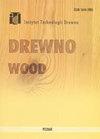海卡尼亚森林阔叶树伐木伤的愈合率及其技术意义。
IF 0.9
4区 农林科学
Q3 MATERIALS SCIENCE, PAPER & WOOD
引用次数: 23
摘要
对伊朗森林234棵受伤树木的伤口愈合率(WHR)进行了调查,发现伤口愈合率在6.4 ~ 24.0 mm·yr -1之间。树种、坡向、海拔、伤龄和伤型对水净比有显著影响。白蜡树(24 mm·yr -1)、亚心桤木(18.9 mm·yr -1)和东方Fagus (17.9 mm·yr -1)的WHR平均值显著高于槭(15.7 mm·yr -1)、槭(14.6 mm·yr -1)、桦木(13.7 mm·yr -1)和秋海莲(6.4 mm·yr -1)。此外,北坡的平均水热比(17.5 mm·yr -1)显著高于南坡。此外,对树木生长有积极影响的参数对伤口愈合率也有类似的影响。5岁、10岁和15岁伤口的whr分别为19.3、16.9和10 mm·yr -1。离地高度越高,伤高比越高。水平创面的WHR (18.4 mm·yr -1)显著高于垂直创面。冠层封闭度为60 ~ 80%的林分,其净水比最高。随缠绕宽度的增加,腰宽比减小。创伤会影响未来的收入,减少树木的数量,而这些树木可能提供更高质量的锯木和贴面原木。本文章由计算机程序翻译,如有差异,请以英文原文为准。
Healing rate of logging wounds on broadleaf trees in Hyrcanian forest with some technological implications.
The wound healing rate (WHR) was investigated in 234 wounded trees in Iranian forests and was found to range from 6.4 to 24.0 mm·yr -1 . Tree species, slope aspect, elevation, wound age, and wound type had significant effects on the WHR. The mean of the WHR in the Fraxinus excelsior (24 mm·yr -1 ), Alnus subcordata (18.9 mm·yr -1 ) and in the Fagus orientalis (17.9 mm·yr -1 ) were significantly higher than in the Acer insigne (15.7 mm·yr -1 ), Acer cappadocicum (14.6 mm·yr -1 ), Carpinus betulus (13.7 mm·yr -1 ), and Tilia begonifolia (6.4 mm·yr -1 ). In addition, the mean of the WHR on northern slopes (17.5 mm·yr -1 ) was significantly higher than on southern slopes. Moreover, the parameters that positively influenced tree growth showed a similar effect on the wound healing rate. The WHRs of 5-, 10- and 15-year-old wounds were 19.3, 16.9 and 10 mm·yr -1 , respectively. The WHR increased the higher the wound from ground level. The WHR for horizontal wounds (18.4 mm·yr -1 ) was significantly higher than for vertical wounds. The highest WHR was estimated in a stand with a canopy closure of 60-80%. The WHR decreased according to increasing wound width. Wounds affect future income, lowering the number of trees that potentially provide a higher quality of saw and veneer logs.
求助全文
通过发布文献求助,成功后即可免费获取论文全文。
去求助
来源期刊

Drewno
MATERIALS SCIENCE, PAPER & WOOD-
CiteScore
1.10
自引率
12.50%
发文量
0
审稿时长
>12 weeks
期刊介绍:
Wood. Research papers. Reports. Announcements" ("Drewno") is an international scientific journal that publishes original results of innovatory basic and applied research concerning technological, technical, economic and ecological issues important for the wood science and forest-based industries, including their environment, and interesting to the international recipients. "Drewno" is an Open Access biannual journal.
Aims and scope:
wood science: anatomy, biology, chemistry, physics
wood mechanical and chemical technology, inter alia, sawmilling, composite wood products, wooden construction, furniture making, wood pulp, paper making
material engineering, biocomposites, nanocomposites
material management
environmental protection, safety of the processes, products and working stations
biotechnology
bioenergy, biofuels
forestry: harvesting and wood quality
wood-based industries economics
The Editorial Board of the journal especially welcomes articles concerning increase in wood resources (wood mobilisation); innovative composites and lignocellulosic materials; new trends in the protection, modification and finishing of wood; biorefining of raw wood material; "green" building; new technologies of wood waste recycling; sustainable development; innovation management; and business networks.
 求助内容:
求助内容: 应助结果提醒方式:
应助结果提醒方式:


